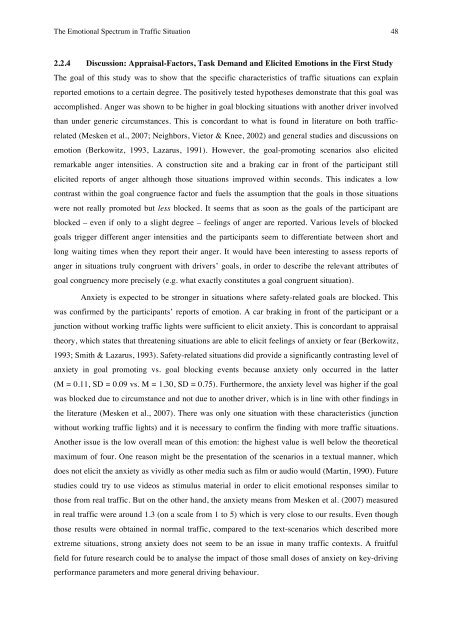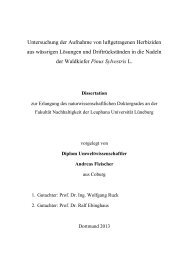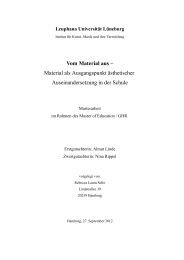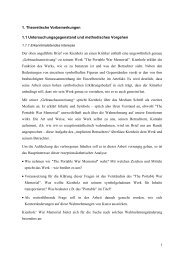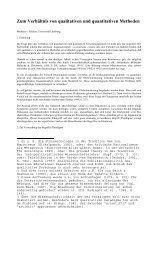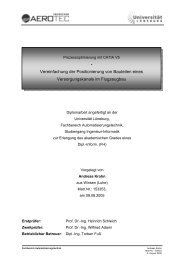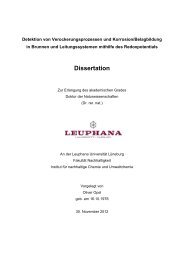Determinants of Emotional Experiences in Traffic Situations ... - OPUS
Determinants of Emotional Experiences in Traffic Situations ... - OPUS
Determinants of Emotional Experiences in Traffic Situations ... - OPUS
You also want an ePaper? Increase the reach of your titles
YUMPU automatically turns print PDFs into web optimized ePapers that Google loves.
The <strong>Emotional</strong> Spectrum <strong>in</strong> <strong>Traffic</strong> Situation 48!<br />
2.2.4 Discussion: Appraisal-Factors, Task Demand and Elicited Emotions <strong>in</strong> the First Study<br />
The goal <strong>of</strong> this study was to show that the specific characteristics <strong>of</strong> traffic situations can expla<strong>in</strong><br />
reported emotions to a certa<strong>in</strong> degree. The positively tested hypotheses demonstrate that this goal was<br />
accomplished. Anger was shown to be higher <strong>in</strong> goal block<strong>in</strong>g situations with another driver <strong>in</strong>volved<br />
than under generic circumstances. This is concordant to what is found <strong>in</strong> literature on both trafficrelated<br />
(Mesken et al., 2007; Neighbors, Vietor & Knee, 2002) and general studies and discussions on<br />
emotion (Berkowitz, 1993, Lazarus, 1991). However, the goal-promot<strong>in</strong>g scenarios also elicited<br />
remarkable anger <strong>in</strong>tensities. A construction site and a brak<strong>in</strong>g car <strong>in</strong> front <strong>of</strong> the participant still<br />
elicited reports <strong>of</strong> anger although those situations improved with<strong>in</strong> seconds. This <strong>in</strong>dicates a low<br />
contrast with<strong>in</strong> the goal congruence factor and fuels the assumption that the goals <strong>in</strong> those situations<br />
were not really promoted but less blocked. It seems that as soon as the goals <strong>of</strong> the participant are<br />
blocked – even if only to a slight degree – feel<strong>in</strong>gs <strong>of</strong> anger are reported. Various levels <strong>of</strong> blocked<br />
goals trigger different anger <strong>in</strong>tensities and the participants seem to differentiate between short and<br />
long wait<strong>in</strong>g times when they report their anger. It would have been <strong>in</strong>terest<strong>in</strong>g to assess reports <strong>of</strong><br />
anger <strong>in</strong> situations truly congruent with drivers’ goals, <strong>in</strong> order to describe the relevant attributes <strong>of</strong><br />
goal congruency more precisely (e.g. what exactly constitutes a goal congruent situation).<br />
Anxiety is expected to be stronger <strong>in</strong> situations where safety-related goals are blocked. This<br />
was confirmed by the participants’ reports <strong>of</strong> emotion. A car brak<strong>in</strong>g <strong>in</strong> front <strong>of</strong> the participant or a<br />
junction without work<strong>in</strong>g traffic lights were sufficient to elicit anxiety. This is concordant to appraisal<br />
theory, which states that threaten<strong>in</strong>g situations are able to elicit feel<strong>in</strong>gs <strong>of</strong> anxiety or fear (Berkowitz,<br />
1993; Smith & Lazarus, 1993). Safety-related situations did provide a significantly contrast<strong>in</strong>g level <strong>of</strong><br />
anxiety <strong>in</strong> goal promot<strong>in</strong>g vs. goal block<strong>in</strong>g events because anxiety only occurred <strong>in</strong> the latter<br />
(M = 0.11, SD = 0.09 vs. M = 1.30, SD = 0.75). Furthermore, the anxiety level was higher if the goal<br />
was blocked due to circumstance and not due to another driver, which is <strong>in</strong> l<strong>in</strong>e with other f<strong>in</strong>d<strong>in</strong>gs <strong>in</strong><br />
the literature (Mesken et al., 2007). There was only one situation with these characteristics (junction<br />
without work<strong>in</strong>g traffic lights) and it is necessary to confirm the f<strong>in</strong>d<strong>in</strong>g with more traffic situations.<br />
Another issue is the low overall mean <strong>of</strong> this emotion: the highest value is well below the theoretical<br />
maximum <strong>of</strong> four. One reason might be the presentation <strong>of</strong> the scenarios <strong>in</strong> a textual manner, which<br />
does not elicit the anxiety as vividly as other media such as film or audio would (Mart<strong>in</strong>, 1990). Future<br />
studies could try to use videos as stimulus material <strong>in</strong> order to elicit emotional responses similar to<br />
those from real traffic. But on the other hand, the anxiety means from Mesken et al. (2007) measured<br />
<strong>in</strong> real traffic were around 1.3 (on a scale from 1 to 5) which is very close to our results. Even though<br />
those results were obta<strong>in</strong>ed <strong>in</strong> normal traffic, compared to the text-scenarios which described more<br />
extreme situations, strong anxiety does not seem to be an issue <strong>in</strong> many traffic contexts. A fruitful<br />
field for future research could be to analyse the impact <strong>of</strong> those small doses <strong>of</strong> anxiety on key-driv<strong>in</strong>g<br />
performance parameters and more general driv<strong>in</strong>g behaviour.


